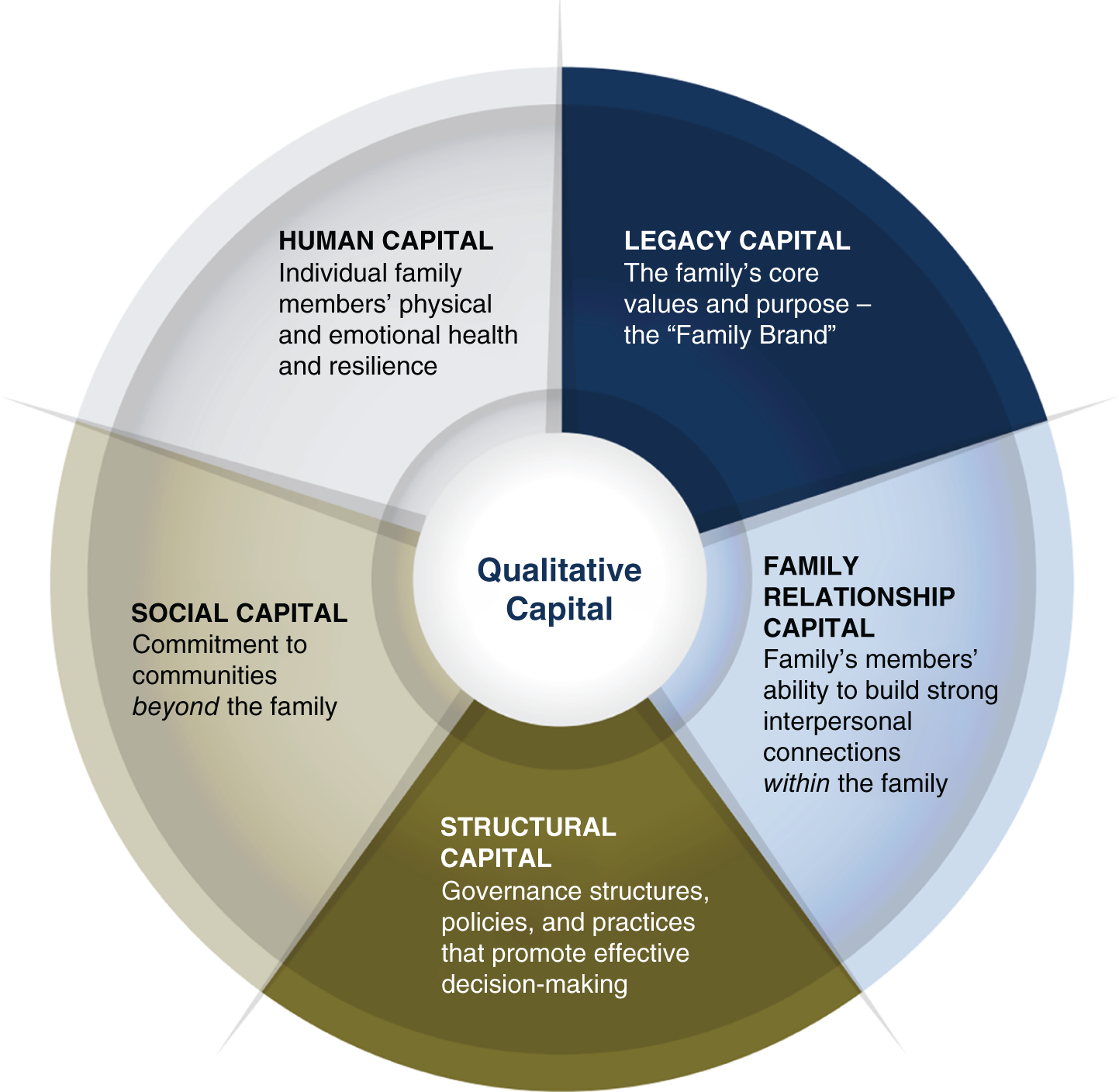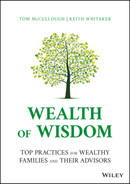Assessing Your Family's True Needs
Keith Whitaker
When you review the table of contents of this book, a particular chapter or exercise might stand out to you, as addressing your family's true needs.
You may wonder, however, “What are my family's true needs?” So often there are possibilities for growth and learning that we are not even aware of.
This section offers you a way to assess your family's needs when it comes to living well with significant wealth. It does so by adapting the Family Balance Sheet, an assessment tool designed by Wise Counsel Research, a consultancy that works with some of the most enterprising families around the world.
Wise Counsel's Family Balance Sheet was developed based on research into what leads families to succeed when they are engaged over multiple generations in managing significant financial wealth or a family business. This research includes Wise Counsel Research's 100-Year Family Study, which studied more than 100 families around the world who have transitioned a family enterprise through at least three generations of family leadership.1 From this research and practice, Wise Counsel identified five factors of long-term family success, each of which aligns with one of five forms of nonfinancial or, as we call it, “Qualitative Capital”:
| Success Factors | Qualitative Capital | |
| 1 | Long-term resiliency, growth, and development | Human Capital |
| 2 | Shared values and core purpose | Legacy Capital |
| 3 | Cross-generational engagement and support | Family Relationship Capital |
| 4 | Governance policies and structures that guide development and decisions | Structural Capital |
| 5 | Commitment to community beyond family | Social Capital |
The five forms of Qualitative Capital can be represented this way:

Since the five forms of Qualitative Capital are grounded in these five success factors, by measuring and then intentionally growing each form of Qualitative Capital, a family ensures a legacy of true wealth to its descendants.
Who is Your Family?
Following I offer an abbreviated version of Wise Counsel's Family Balance Sheet. (It represents about one-quarter of the original assessment.) This exercise will allow you to begin to assess your family regarding the five forms of Qualitative Capital. From this self-assessment then flows possible directions for your reading.
As you review the assessment, you'll notice that it asks you about “my family.” Think about who you consider family for this purpose. Who are you managing money or a business with or for? How about their spouses? Where do you draw the line around “my family”? There are no right answers to these questions. One of the points of the exercise is to prompt these thoughts.
If you are an advisor filling out the assessment regarding a client family, think through those same questions based on your knowledge and experience of how the family speaks and acts.
As you complete the assessment, you may want to consider how other members of your family (or how members of your client family) would respond. Would their responses be significantly different from yours? Do you have enough information to be able to guess accurately at their responses? Perhaps not, which itself points to a key area of opportunity: to learn how your family members view themselves.
Again, the main reason for offering you this abbreviated form of the Family Balance Sheet here is to help you orient yourself to promising lines of inquiry in reading this book. Following the assessment, I offer recommendations for sections and chapters to consider based on your results.
It may also help to know how Wise Counsel uses the fuller version of this assessment. Every year we ask every adult in our client families to fill out the Family Balance Sheet. We aggregate those results to create a report that details the family's Qualitative Capital. It benchmarks the family's results against the over 200 global families in our database. And this annual report highlights for the family its areas of strength and areas of opportunity for growth and learning.
Based on those results and benchmarks, we present the family with recommendations for actions and education that are based on a sound diagnosis of the family's current conditions. We convene family members in at least two family meetings each year, at which they discuss these recommendations, prioritize the actions they want to take, and evaluate their progress in pursuing these plans. As a result, families who engage in this annual, iterative process of “Family Qualitative Capital Management” measure, manage, and grow their nonfinancial wealth with the same intentionality and results as with their financial assets. You can learn more about Family Qualitative Capital Management at Wise Counsel's website, www.wisecounselresearch.com.
Let's turn now to the assessment.
On the following pages, you'll find a definition of each of the five forms of Qualitative Capital. You'll be asked to respond to each statement on a scale of 1 to 5, from “Strongly Disagree” to “Strongly Agree.” At the bottom of each form, you'll see a space where you can add up the numerical total of your responses. Following the assessment are recommendations for sections of the book to consider reading.
Assessing Your Family's True Needs—Abbreviated Family Balance Sheet
As you read the following statements, think about your family and mark down your initial responses. Respond to the statements as honestly as possible; don't overthink the statements or your answers.
Human Capital: Family members' physical and emotional health and ability to grow, learn, and adapt.
1 = Strongly Disagree, 2 = Disagree, 3 = Neutral, 4 = Agree, 5 = Strongly Agree
- Most of my family members have good physical health.
1 2 3 4 5 - Most of my family members have good psychological health.
1 2 3 4 5 - Most of my family members are engaged in meaningful work.
1 2 3 4 5 - Most of my family members feel emotionally connected with people they care about.
1 2 3 4 5
Total for Human Capital: __________
Legacy Capital: The family's core values and purpose.
1 = Strongly Disagree, 2 = Disagree, 3 = Neutral, 4 = Agree, 5 = Strongly Agree
- My family members share stories about the family's history.
1 2 3 4 5 - My family members work to maintain shared traditions.
1 2 3 4 5 - My family has clarified its guiding values.
1 2 3 4 5 - My family has a shared vision for its future.
1 2 3 4 5
Total for Legacy Capital: __________
Family Relationship Capital: Family members' ability to build strong interpersonal connections with each other.
1 = Strongly Disagree, 2 = Disagree, 3 = Neutral, 4 = Agree, 5 = Strongly Agree
- My family members communicate effectively about difficult topics.
1 2 3 4 5 - Most of my family members work well with each other.
1 2 3 4 5 - Most of my family members trust each other.
1 2 3 4 5 - The family includes members' spouses in important discussions.
1 2 3 4 5
Total for Family Relationship Capital: __________
Structural Capital: Structures, policies, and practices for effective decision-making.
1 = Strongly Disagree, 2 = Disagree, 3 = Neutral, 4 = Agree, 5 = Strongly Agree
- My family members have a good understanding of their personal finances.
1 2 3 4 5 - My family has clearly communicated policies regarding the management of shared financial assets.
1 2 3 4 5 - My family has effective family meetings.
1 2 3 4 5 - My family has a clear plan for transition to the next generation of family leadership.
1 2 3 4 5
Total for Structural Capital: __________
Social Capital: Commitment to communities beyond the family.
1 = Strongly Disagree, 2 = Disagree, 3 = Neutral, 4 = Agree, 5 = Strongly Agree
- My family cultivates in its members a spirit of giving to others.
1 2 3 4 5 - Most of my family members are using their financial assets to make a positive difference in the world.
1 2 3 4 5 - My family's philanthropy reflects individual family members' values.
1 2 3 4 5 - My family allocates funds for individual family members to pursue their own philanthropic interests.
1 2 3 4 5
Total for Social Capital: __________
Interpreting the Results
First, look at the sum you added up for each capital. Each sum should be a number between 4 and 20.
- If the sum for a particular capital is 18 or higher, that result indicates that your family likely enjoys a significant strength in that capital. Only 10% of families in Wise Counsel's survey population enjoy such high results in any one capital.
- If the sum for a capital is between 14 and 17, that result indicates that your family has a developing strength in that capital. Nearly 40% of families have results in this range in each of the five forms of Qualitative Capital.
- If the sum in a capital is less than 14, then that capital needs attention. But don't despair. At least 50% of families have results in this range when they begin the intentional work of growing their Qualitative Capital.
Once you have surveyed your overall results, look more closely at each capital. Where in that capital did you rate your family most highly? Where lowest? Again, ask yourself if your responses would likely be shared by other family members. If not, what would explain the possible differences?
Directions in Reading
All the sections and chapters of this book touch upon at least one, and often several, of the five forms of Qualitative Capital. Here are suggestions for further reading, keyed to each form of Qualitative Capital. If you or your family members scored your family on the lower range regarding a particular capital, review these sections' introductions and see which chapters in those sections could be particularly promising places for you to begin:
Human Capital
Legacy Capital
Family Relationship Capital
Structural Capital
- Section 3: Planning Thoughtfully
- Section 4: Investing Wisely
- Section 5: Seeking Sound Advice
- Section 8: Making Shared Decisions
Social Capital
Additional Resources
For more on the Family Balance Sheet and the Family Qualitative Capital Management Program, see www.wisecounselresearch.com.
In addition, you can learn more about Family Qualitative Capital from:
James E. Hughes, Jr., Susan E. Massenzio, and Keith Whitaker, Complete Family Wealth, 2nd ed. (New York: Wiley, 2022).
James E. Hughes, Jr., Susan E. Massenzio, and Keith Whitaker, The Cycle of the Gift (New York: Wiley, 2012).
James E. Hughes, Jr., Susan E. Massenzio, and Keith Whitaker, The Voice of the Rising Generation (New York: Wiley, 2013).
Biography
Dr. Keith Whitaker is an educator who consults with leaders and rising generation members of enterprising families. Family Wealth Report named Keith the 2015 “outstanding contributor to wealth management thought-leadership.” Keith's writings and commentary have appeared in the Wall Street Journal, New York Times, and Financial Times. He is the co-author of Wealth and the Will of God, The Cycle of the Gift, The Voice of the Rising Generation, Family Trusts, Complete Family Wealth, and Wealth of Wisdom: The Top 50 Questions Wealthy Families Ask. Keith has served as a managing director at Wells Fargo Family Wealth, an adjunct professor of management at Vanderbilt University, and an adjunct assistant professor of philosophy at Boston College. Keith holds a Ph.D. in social thought from the University of Chicago and a BA and MA in classics and philosophy from Boston University.
Note
- 1 See Dennis T. Jaffe, Borrowed from Your Grandchildren: The Evolution of 100-Year Family Enterprises (New York: Wiley, 2020).
